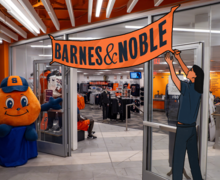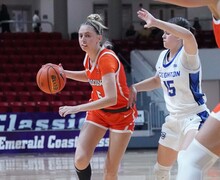Switching lanes: New bike lane serves as catalyst for thriving bike culture on campus
Sam Maller | Staff Photographer
Sara Morris, who runs Mello Velo Bicycle Shop on Wescott Street with her husband, straightens the spokes on a tire on Tuesday afternoon.
Just with a helmet in hand, Leslie Walters sparks conversations.
Walters has had her bike on campus since late July. While she visited various locations on Marshall Street, she found people often inquired about her bike.
“It’s good to locate people with bikes on campus because then you can ride together,” said Walters, a sophomore broadcast and digital journalism major.
Cyclists will find Syracuse University’s campus friendlier due to the bike lanes recently constructed along University Avenue from Genesee Street to Waverly Avenue. The bright green, reflective pathway, along with the two-way traffic road conversion are features that planners hope will make the Connective Corridor more accommodating to the SU community.
The bike lane extension’s work will continue along East Genesee Street to Almond Street, and will be completed by the middle of October, continuing across the city and eventually reaching The Warehouse.
The Office of Off-Campus and Commuter Services building received a bike installation just two or three weeks after requesting one from the Physical Plant, said Elin Riggs, the director of the Office of Off-Campus and Commuter Services.
While taking classes during the summer, Walters said she discovered bike-friendly places in the area with friends who also like biking. Like many students on campus, Walters is still discovering how biking can be a beneficial transportation choice, despite some risks.
Not having to worry about parking or slow buses, getting more exercise and feeling less vulnerable when traveling around campus alone are advantages of being a cyclist on campus, Walters said. Teddy Ellison, an SU alumnus, said a benefit is that he saves around $40 to $50 on gas per month by riding his bike most places instead of driving.
Sara Morris, a 2009 alumnus, runs a bike shop and cafe with her husband in the Westcott area called Mello Velo.
Biking is not as scary as many people think and can be a great way to explore the city. With more safety features like bike lanes, she said, people feel even more comfortable taking advantage of what the city has to offer.
Mello Velo began in the couple’s garage and has been steadily growing over the years. Morris attributed the growth of the business to the increasing popularity of biking in the area.
“I think it’s a great shop,” Ellison said. “I’ve gone there ever since they’ve opened and I still go there today.”
Ellison said he especially likes the community bike rides that the storeowners organize every Thursday at 8 p.m. Attending the rides that are usually around 13 miles long is a great way to meet people, Ellison said.
The Thursday bike rides that begin at Morris’s repair shop and travel throughout the city of Syracuse have been growing: A record 77 people attended last week. Participants range from the homeless to professional racers, Morris said.
“I feel like we are helping to build a community,” Morris said.
Seeing people connect as a result of their shared interest in biking is one of Morris’s favorite aspects of her job.
But she said the increase in the popularity of biking can have some negative effects, one of the most common being theft.
It is not uncommon, Morris said, for a customer’s bike to be stolen off the street as he or she purchases supplies at the repair shop or gets a coffee at the cafe.
Ellison said he is, unfortunately, all too familiar with this risk. A bike that cost him around $1,000 was stolen right off a friend’s front porch in Manlius, N.Y. back in 2006, and more recently, somebody almost rode off with his bike at Graby’s Mini Mart.
“I’d left my bike outside at a certain spot that I can see through a window in the store,” he said. “Somebody grabbed it and I had to chase after them.”
Luckily, Ellison said, the criminal flipped the bike after realizing he’d been caught.
Locking up bikes with steel U-Bolt locks when they are not in use is one of the best ways to prevent bike robbery, said Department of Public Safety Chief Tony Callisto, because U-Bolt locks require tools and take a significant amount of time to break.
“The chances of a bike getting stolen with a U-Bolt are almost zero,” he said.
Cable locks, however, are far less secure, Callisto said.
“A bike thief often looks for bikes that are unattended or are locked with cable locks,” Callisto said. “Many cable locks are easily defeated by even small bolt cutters.”
However, Caitlin Klotz found having a U-Bolt lock is not guaranteed protection from bike theft — the bike must also be properly secured.
During the summer, her bike, which was secured with both a chain and U-Bolt lock, was stolen when she improperly locked the bike.
“I did it backwards,” said Klotz, a junior environmental resource and engineering major.
The U-Bolt was around the tire of the bike and the chain was around the bike’s frame, she said. Whoever stole her bike cut the chain and stole a tire off another bike.
DPS Officer John Sardino said students should register their bikes with DPS to increase the chance of recovery if they are stolen.
Aside from robbery, accidents are another hazard of biking with the heavy traffic of motorists and pedestrians in the area.
Students on campus should know, Callisto said, that cyclists must follow the same rules of the road as drivers, especially since it is technically not legal for cyclists to ride on sidewalks.
Officer Sardino said it is also important that cyclists know the appropriate hand signals to let drivers know where they intend to move.
Wearing a helmet and always being attentive while biking, especially avoiding the use of headphones, are other safety tips both officers stressed to avoid accidents.
Walters said she hopes students will continue to take advantage of the bike lanes and that more will be built to make the city more accessible to students.
Said Walters: “The world really opens up when you actually have transportation like that.”
Published on September 5, 2012 at 2:25 am
Contact Shannon: smhazlit@syr.edu





